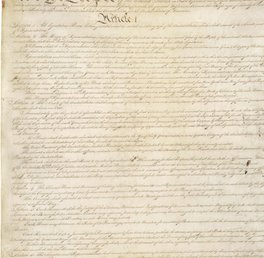
For more public domain images of the Constitution visit the National Archives
In 2004 under Senator Byrd's urging, Congress changed the designation of this day to "Constitution Day and Citizenship Day" and added the requirement that each educational institution which receives Federal funds should commemorate September 17th each year. [It should also be noted that September 17-23 was dedicated as Constitution Week through a Congressional resolution in 1956]
This day has its origins in a Congressional joint resolution in 1940 requesting the President to issue a proclamation setting aside the third Sunday in May for the recognition of all who had attained American citizenship. In 1952, Congress repealed this resolution and passed a law moving the date to September 17th. This law urged authorities of states, counties, cities and towns to make plans for the observance of the day.

Tyler v. Hennepin County, MN (2023)
Dr. Michael Hart, from the College of Southern Nevada, discusses
Tyler v. Hennepin County, MN (2023) and
government seizure of property for unpaid taxes.

Affirmative Action & the 14th Amendment
Dr. Francis Carleton, from the College of Southern Nevada, discusses race-based affirmative action and the 14th Amendment and the question of equal protection.

Kelo v. City of New London (2005)
Dr. Kenneth Fernandez, from the College of Southern Nevada, discusses the U.S. Supreme Court case Kelo v. City of New London (2005) and the use of eminent domain.
Privacy Rights and Abortion - Francis Carleton, PhD (2022)
NYSRPA v. Bruen (2022) and the 2nd Amendment - Michael Hart, PhD (2022)
Stop & Identify Laws - The Hiibel case (2004) - Kenneth Fernandez, PhD (2021)
Torres v. Mandrid (2021) and the Fourth Amendment - Michael Hart, PhD (2021)
Vaccine Mandates and the Due Process Clause - Francis Carleton, PhD (2021)
Where does the right to privacy come from? - Kenneth Fernandez, PhD (2020)
Chiafalo v. Washington: Faithless Electors - Michael Hart, PhD (2020)
Why is the Constitution Unique
The Constitution of the United States: A Transcription
The Constitution Project: A variety of videos
The National Constitutional Center
Full Text of the Federalist Papers
US Census Constitution Day Webpage
